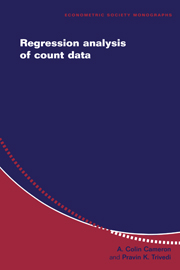Book contents
- Frontmatter
- Contents
- List of Figures
- List of Tables
- Preface
- 1 Introduction
- 2 Model Specification and Estimation
- 3 Basic Count Regression
- 4 Generalized Count Regression
- 5 Model Evaluation and Testing
- 6 Empirical Illustrations
- 7 Time Series Data
- 8 Multivariate Data
- 9 Longitudinal Data
- 10 Measurement Errors
- 11 Nonrandom Samples and Simultaneity
- 12 Flexible Methods for Counts
- Appendices
- References
- Author Index
- Subject Index
- Titles in the series
8 - Multivariate Data
Published online by Cambridge University Press: 05 January 2013
- Frontmatter
- Contents
- List of Figures
- List of Tables
- Preface
- 1 Introduction
- 2 Model Specification and Estimation
- 3 Basic Count Regression
- 4 Generalized Count Regression
- 5 Model Evaluation and Testing
- 6 Empirical Illustrations
- 7 Time Series Data
- 8 Multivariate Data
- 9 Longitudinal Data
- 10 Measurement Errors
- 11 Nonrandom Samples and Simultaneity
- 12 Flexible Methods for Counts
- Appendices
- References
- Author Index
- Subject Index
- Titles in the series
Summary
Introduction
In this chapter we consider regression models for an m-dimensional vector of jointly distributed, and in general correlated, random variables y = (y1, y2, …, ym), a subset of which are event counts. A special case is if m = 2, y1 is a count, and y2 is either discrete or continuous. Multivariate data appear in three contexts in this book. The first is basic cross-section, which is the main subject of this chapter. The second is longitudinal data with repeated measures over time on the same variable, leading to special correlation structure handled in Chapter 9. The third is the context of multivariate cross-section data with endogeneity or feedback from yj to yk, dealt with in Chapter 10. There are other forms of multivariate data, such as multivariate time series analogs of Gaussian vector autoregressions, that we do not cover.
Multivariate linear Gaussian models are widely used, but multivariate nonlinear, non-Gaussian models are less common. Fully parametric approaches based on the joint distribution of non-Gaussian vector y, given a set of covariates x, are difficult to apply because analytically and computationally tractable expressions for such joint distributions are available for special cases only. Consequently, it is more convenient to analyze models that are of interest in specific situations.
Multivariate cross-section count models arise in several different settings. The first is that in which several related events are measured as counts and the joint distribution of several counts is required. These models are analogous to the seemingly unrelated regressions model.
- Type
- Chapter
- Information
- Regression Analysis of Count Data , pp. 251 - 274Publisher: Cambridge University PressPrint publication year: 1998



